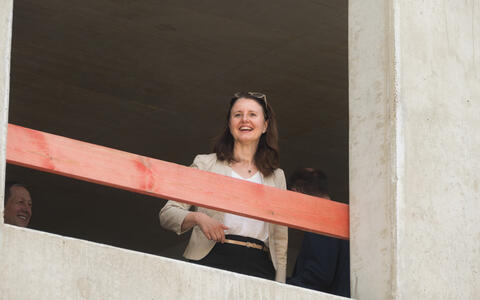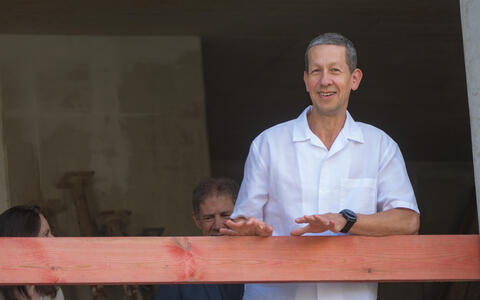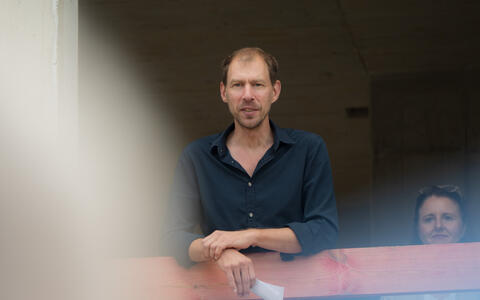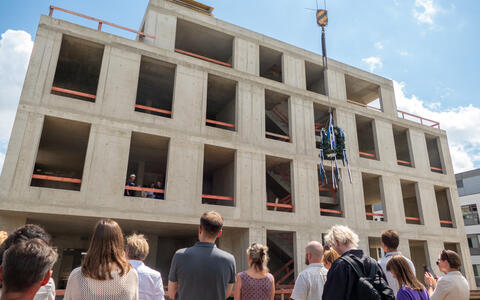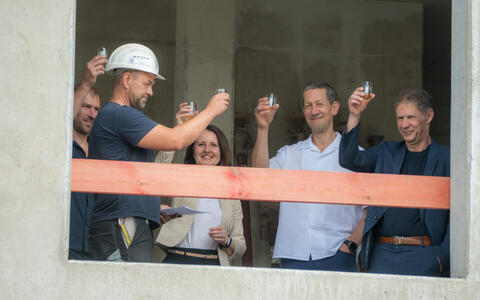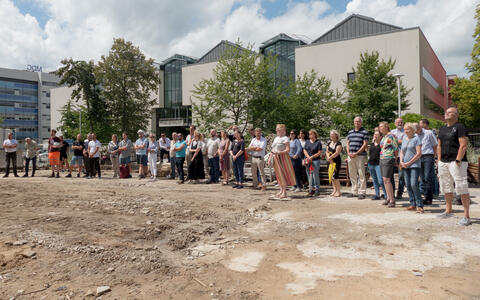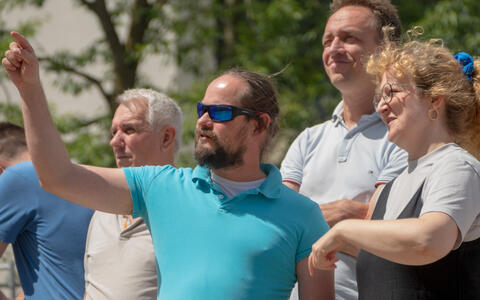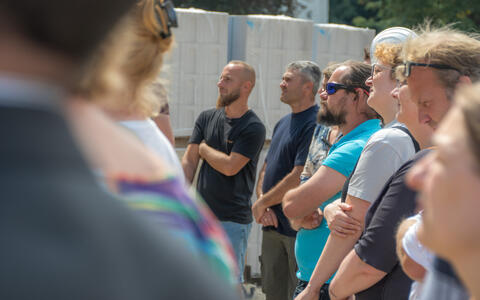The Imaging Innovation Center hits a milestone
A state-of-the-art facility for leading researchers in imaging and AI is almost complete: After nearly a year and a half of construction, the architects, builders and scientists is celebrating the new Imaging Innovation Center (IIC) of the Max Delbrück Center for Molecular Medicine in the Helmholtz Association with a “topping out ceremony” on July 11, 2024, on the Campus Buch in Berlin. In the new building, research teams and technology experts from the Max Delbrück Center, including the platforms for Advanced Light Microscopy and Electron Microscopy, as well as new working groups, will cooperate closely to develop imaging technologies starting in 2026. The new IIC will integrate imaging with data analyses and include AI-supported methods. Physicists, biophysicists, life scientists, and bioinformaticians will work closely together. Additionally, companies will have the opportunity to test and make available the latest developments in a "Demonstrator Space for Microscopy."
Rendering of the Imaging Innovation Center (IIC).
Imaging as a driving force in biomedicine
"Imaging techniques significantly advance biomedical research and have led to revolutionary discoveries. Any innovation in microscopy that allows us to observe biological phenomena between molecules in cells, organs, and the organism with higher temporal and spatial resolution can dramatically change our understanding of diseases," said Professor Holger Gerhardt, Deputy Scientific Director of the Max Delbrück Center, at the topping-out ceremony. He further added: "Investing in the use and development of imaging techniques and image data analysis in our new IIC is an important strategic positioning. It is essential to fulfill our mission: Discovery for Tomorrow's Medicine."
Heike Graßmann, Administrative Director of the Max Delbrück Center, expressed gratitude to the federal and state governments as well as all the companies and craftsmen involved in the construction: "If you want to enable world-leading research in Berlin in the coming decades, you have to invest wisely today. Thanks to the strategically forward-looking decision by the federal and state governments, we are able to invest nearly 32 million euros in the construction of this new life sciences research building on our campus. I am particularly pleased that we have managed to advance the construction so significantly in just one and a half years by working together diligently."
Highly sensitive microscopy on almost 3000 square meters
The three-and-a-half-story building with a total usable area of 2.675 square meters was planned by the architects at heinlewischer, which has already realized several buildings on the campus. The construction costs of the publically funded building, originally to be named Optical Imaging Center, amount to €31,873 million. The building is located directly next to the Isolde-Diedrich House for Cryo-Electron Microscopy and integrates ideally into the ensemble of research buildings on the campus. Like the Cryo-EM, the IIC rests on a massive base plate that compensates for shifts in the building’s structure. This low-vibration construction, ensures that the highly sensitive light and electron microscopes are not affected by any movement. A highly precise air conditioning system will ensure stable temperature and constant humidity in the laboratories. The building will be built to the highest energy conservation standards, i.e., prepared for the transition to future energy sources and is equipped with photovoltaics and geothermal collectors; it is expected to receive the silver certificate of the sustainable building rating system BNB.
The architect Dr. Alexander Gyalokay from heinlewischer said: "It is always a challenge to meet the specific requirements of science on the one hand and the demands for flexibility and cost-effectiveness on the other. Optical imaging requires vibration-resistant buildings with temperature-stable rooms, which we will construct here in a rare concentration. We are proud to be involved in such a project."
Photos
- Heike Graßmann, Heike Graßmann, Administrative Director of the Max Delbrück Center, in the shell of the IIC.
- Holger Gerhardt, Vice Director of the Max Delbrück Center, during his speech at the topping-out ceremony.
- Alexander Architect Alexander Gyalokay during his speech.
- The topping-out crown above the IIC.
Further Information
Contact
Jutta Kramm
Head of communication
Max Delbrück Center
+49 30 9406-2140
jutta.kramm@mdc-berlin.de or presse@mdc-berlin.de
Dr. Tania Ost
Information department
Heinlewischer Partnerschaft freier Architekten mbB
+49 30 399920-90
info@heinlewischer.de
- Max Delbrück Center
-
The Max Delbrück Center for Molecular Medicine in the Helmholtz Association (Max Delbrück Center) is one of the world’s leading biomedical research institutions. Max Delbrück, a Berlin native, was a Nobel laureate and one of the founders of molecular biology. At the locations in Berlin-Buch and Mitte, researchers from some 70 countries study human biology – investigating the foundations of life from its most elementary building blocks to systems-wide mechanisms. By understanding what regulates or disrupts the dynamic equilibrium of a cell, an organ, or the entire body, we can prevent diseases, diagnose them earlier, and stop their progression with tailored therapies. Patients should be able to benefit as soon as possible from basic research discoveries. This is why the Max Delbrück Center supports spin-off creation and participates in collaborative networks. It works in close partnership with Charité – Universitätsmedizin Berlin in the jointly-run Experimental and Clinical Research Center (ECRC), the Berlin Institute of Health (BIH) at Charité, and the German Center for Cardiovascular Research (DZHK). Founded in 1992, the Max Delbrück Center today employs 1,800 people and is 90 percent funded by the German federal government and 10 percent by the State of Berlin.



